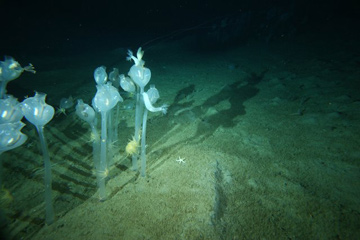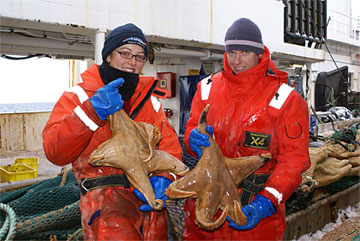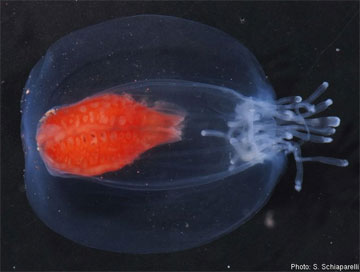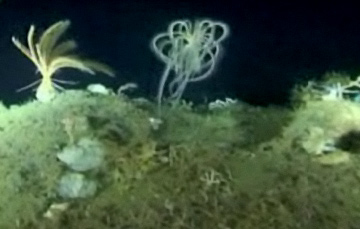Photos: Giant sea creatures discovered in Antarctica
An eight week long survey of New Zealand’s Antarctic waters has turned up giant creatures including jellyfish with 12-foot tentacles and 2-foot-wide starfish, as well as up to eight previously undiscovered species of mollusc, reports the Associated Press (A.P.).
“Gigantism is very common in Antarctic waters — we have collected huge worms, giant crustaceans and sea spiders the size of dinner plates.” said Dr Martin Riddle, leader of Aurora Australis expedition, one of 11 voyages that are part of the International Polar Year program, a census of life in the cold Southern Ocean. The New Zealand expedition to the Ross Sea was undertaken on the RV Tangaroa.
The large size of polar species may be linked to cold temperatures, a limited number of predators, high oxygen levels, and longevity, Dr. Don Robertson, a marine scientist with New Zealand’s National Institute of Water and Atmospheric Research (NIWA), told the A.P.
 The stalked structures looking like glass tulips are actually animals known as tunicates. They are early colonizers of areas recently disturbed by ice-berg scouring. They filter food particles from the water by pumping it through an internal mesh structure and the stalk is supported by hydrostatic pressure created by their pump. Feather stars (crinoids), sea cucumbers (holothurians) and another species of tunicate have used the stalked tunicates to gain height to give them an advantage in intercepting food particles from the water before it reaches the sea-bed. The sediment surface is covered with a mass of tubes, probably of small polycheate worms. 220m on the continental shelf. Image courtesy of the Census of Antarctic Marine Life.  Sadie Mills, left, and Niki Davey hold giant Macroptychaster sea star (starfish) measuring up to 2 feet across in Antarctic waters. Photo by John Mitchell.  Salp from the neuston net. Photo: S. Schiaparelli  Video capture of a giant sea spider. |
In total, the RV Tangaroa voyage collected some 30,000 specimen, hundreds of which may be new to science.
Among the creature “recovered and identified” include 88 fish, 8 squid and 18 octopus species.
The expedition also aimed to collect data to establish benchmarks for determining the impact of climate change on Antarctica.
“This survey establishes a point of reference to monitor the impact of environmental change in Antarctic waters. For example, ocean acidification, caused by rising atmospheric carbon dioxide levels, will make it harder for marine organisms to grow and sustain calcium carbonate skeletons,” explained Riddle. “It is predicted that the first effects of this will be seen in the cold, deep waters of Antarctica. Our results provide a robust benchmark for testing these predictions.”
“This research will help scientists understand how communities have adapted to the unique Antarctic environment,” Dr Graham Hosie, Project Leader of the Collaborative East Antarctic Marine Census (CEAMARC). “Our work also has wider applications, for example understanding fish community composition and structure is particularly important to explain the impacts of commercial trawling.”